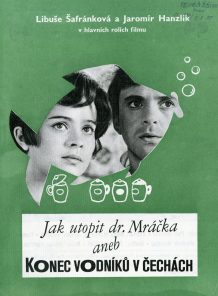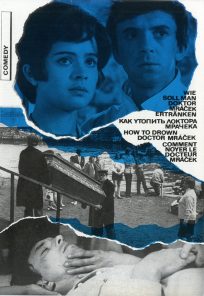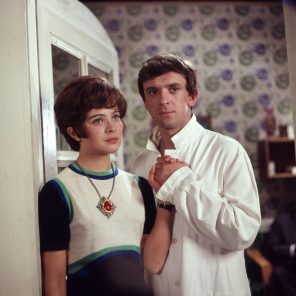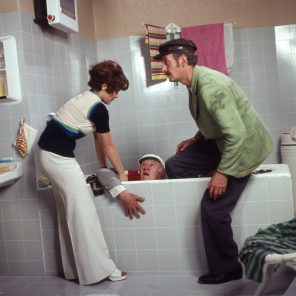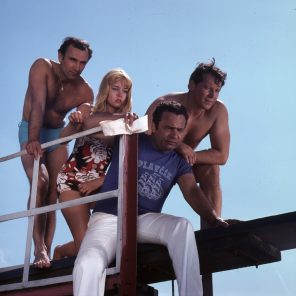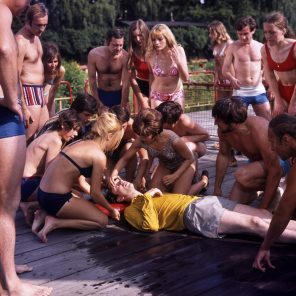In May 1955, the Praha cinema on the Wenceslas Square was adapted for stereoscopic screening. You needed plastic polarization glasses to watch 3D films, such as for instance a program consisting of the Soviet film In the Lights of a Circus Ring (1951) and two Czech short films made using the two-strip method: the documentary May 01 1955 in Prague (1. máj 1955 v Praze) and a passage of Reingold M. Glier’s ballet Red Poppy (Rudý mák).
The co-author of both films and a pioneer of Czech stereoscopic shooting was the cinematographer and inventor Vladimír Novotný,[1] who played an important role in several animated and trick films, popularizing and spreading new technological formats.
Without his ingenious tricks, films such as The Springer and the SS-Men (Pérák a SS), The Czech Year (Špalíček), The Girl on the Broom (Dívka na koštěti), How to Drown Dr. Mráček (Jak utopit dr. Mráčka aneb Konec vodníků v Čechách), Long Live Ghosts! (Ať žijí duchové) or the series Arabela would either never have been made or would look completely different. At the same time, he was among the first in Czechoslovakia to use widescreen film material, having come up with several widgets making the job easier for him and his colleagues – not only cinematographers.
Familiarly called “Mulínek” by his colleagues, Vladimír Novotný was born on 17 October 1914 in Tábor, in house No. 507. He went to primary and secondary school in Tábor. At the end of the 1920s, the family moved to Prague. His older brother Antonín later became an actor and chemical engineer. One of Novotný’s teachers at the Vyšehrad Realgymnasium was a physics teacher and film enthusiast having founded a student cinema in Nusle. Novotný immediately took part in its operation. He made posters, took tickets, and accompanied silent films on the piano.
When seventeen, Novotný was selected to be an extra in Vančura and Innemann’s drama Before Graduation (Před maturitou, 1932), in which his brother played the leading role. More important for him than the small role of a student was the creative environment he entered for the first time thanks to this first film experience. He later recalled this formative experience in Film a doba:
“We were lucky to meet figures such as Vladislav Vančura, Julius Schmitt, and Emil František Burian and actors playing in Before Graduation right at the beginning. This influence was indeed formative in our further activities. Somewhat automatically, we became a new generation – because we felt to be one –, that knew where to focus our creative existence under Vančura’s influence.”[2]
In the 1930s, Novotný played smaller parts in Ballad-Singer (Písničkář, 1932), Mother Kráčmerka (Matka Kráčmerka, 1934), and Hero for a Night (Hrdina jedné noci, 1935) in quick succession. At the same time, he started assisting the founding fathers of the unofficial Czech cinematography school: Karel Degl and Václav Vích. During the compulsory military service, he cooperated with the photographer and filmmaker Jiří Jeníček to produce short military films (Our Army [Naše armáda, 1937], Soldiers in the Mountains [Vojáci v horách, 1938]). In the Military Technical Institute, he also first tried animating moving subtitles and graphs.
His interest in innovative effects gave him the idea to found his own trick studio, which still did not exist in Czechoslovakia at the time. Together with his relative, the painter and graphic designer Josef Vácha, he founded the AFIT film tricks studio in 1935. First located in Prague on Štěpánská Street and later in Smíchov, the studio made subtitles, advertising and opening tags, models, and tricks for many Czech pre-war films produced by film production companies.
During the occupation, the Germans transferred AFIT to under the umbrella production company Prag-Film. Managed by the Germans, he was working on the animated The Wedding in the Coral Sea (Svatba v korálovém moři, 1944), co-animated for instance by Jiří Brdečka, Břetislav Pojar, Václav Bedřich, and other key personalities of Czech animation. Considered the first Czech animated film, the undersea fairy tale was shot on Agfacolor colour negative.
At the end of May 1945, shortly after the liberation, Novotný together with the animated film production manager Jaroslav Jílovec and architect Eduard Hofman asked the 33-year-old artist Jiří Trnka to become the art director of the nationalized animated film studio. Having accepted the offer, Trnka cooperated with Novotný on The Springman and the SS-Men (Pérák a SS, 1946), The Gift (Dárek, 1946), Misha the Bear (Míša Kulička, 1947), or The Czech Year (Špalíček,1947).
What was especially important for Novotný’s future career was assisting the great cinematographer Jan Roth, a frequent collaborator of Martin Frič and Otakar Vávra, between 1947–1948. Novotný’s first independent live action film was Pavel Blumenfeld’s The Little Partisan (Malý partyzán, 1950). Two years later, he could draw on his experience with a drama from the end of World War II in Miloš Makovec’s epic film The Great Adventure (Velké dobrodružství,1952).
Inspired by the traveller Emil Holub’s African expeditions, the film was shot in South Slovakia. The exterior shots were so convincing very much thanks to Novotný, who was shooting the actors through small models of palm groves. Important for him was a mobile camera because he believed that only a panoramic movement could credibly connect a model with actual landscape.
Together with Makovec, Novotný also made Lost People (Ztracenci, 1956) – a balladic anti-war drama inspired by a book by Alois Jirásek. After watching the film, Ivan Dvořák called the hopeful cinematographer “a poet of the black and white image”.[3]
In the 1950s, Novotný repeatedly cooperated with Jiří Krejčík (Dawn above Us [Nad námi svítá, 1952], Frona [1954], Mrs Dulská's Morals [Morálka paní Dulské, 1958], Awakening [Probuzení, 1959]). In the mining drama Dawn above Us, Novotný used his improvement proposal related to depth photography. He used a halved lens hood which, when placed in front of an objective, changed the focal distance for one half of the image.
His original ideas were also given space during the production of the two-part historical comedy The Emperor's Baker – The Baker's Emperor (Císařův pekař – Pekařův císař, 1951), with the main cinematographer being Jan Stallich. For scenes with Jan Werich in the dual role of an emperor and baker, he made up a special camera adapter making sure that in the second exposition, the camera movement would start with one-film-frame precision, and the acts of both Werichs would be synchronized.
For dual expositions, he did not simply content himself with static shots (as had been customary in Czech films until then because it was easier). He also wanted to use panoramic and tracking shots. His device made it possible to start and stop the drive of the camera and, at the same time, to reproduce Werich’s pre-recorded dialogue accompanied by instructions for the actor’s actions in both expositions.
Increasingly sought after by leading Czechoslovak filmmakers – whether for shooting an entire film or “just” for advice on how to deal with a sequence requiring tricks or less common angles and movements – the cinematographer’s inventiveness was not limited to photographic techniques and optical tricks, as illustrated by this memory from 1953:
“I like noticing things around me that do not affect me directly and are not related to my work. So, I noticed the tiring job of editing assistants, manually numbering the copies of image and sound all days. The fact that on one working day each of them only numbered 300 metres best reflects how strenuous the work is. I was thinking a bit and devised and constructed a numbering machine numbering up to 5,000 metres a day, which is perfectly sufficient for all Barrandov cutting rooms.”[4]
In addition to traditional film shooting and screening, Novotný made a sidestep to work for the Laterna magika multimedia theatre, famous, for instance, for the act Musical Joke (Hudební žert) directed by Alfréd Radok. Jiří Šlitr was playing the piano and using stop tricks; there were gradually other Šlitrs appearing on the screen behind him, accompanying their live colleague on the piano. Also thanks to the experience gained with shooting The Emperor’s Baker, Novotný dealt with this five-fold exposition really easily.[5]
In the second half of the 1950s, Novotný was offered to work on the first Czech widescreen film, Provisional Liberty (V proudech, 1957). The realization of the co-production romance was preceded by a trip to France. Novotný was joined by architect Bohuslav Kulič and sound master František Černý. They visited French studios, laboratories, and companies producing film apparatuses and watched several films made using the Cinemascope system with stereo sound. The aim of the trip was to get acquainted with technical equipment for widescreen shooting.
The shooting was delayed due to technical complications with cameras by the French company Debrie. It was originally foreseen to work with Eastman colour material, but it turned out that the Barrandov laboratories could not process it, and that’s why it was replaced by the West German Agfa. The uncertainty as to the resulting image quality led to the decision to create two negatives, which doubled the required material provided by the French.[6] Despite the technologies used, the film emphasizing the beauty and atmosphere of the landscape was mercilessly rejected by domestic critics for its “Western” colour print qualities. [7]
In addition to films with complex tricks, such as The Man from the First Century (Muž z prvního století, 1961) Lemonade Joe or Horse Opera (Limonádový Joe aneb Koňská opera, 1964), Happy End (1967)[8], Novotný also shot Elmar Klos and Jan Kadár’s occupation drama The Shop on Main Street (Obchod na korze, 1965). The Academy Award-winning film well illustrates Novotný’s ability to pick up on any genre and adapt his work to the dramatic intentions of the authors.
The shooting style changes together with the film atmosphere: from the relaxed walk between the strolling crowds during the nearly comedic introduction to the pressing movement through the cramped rooms of the shop. At the end, the camera basically takes over the role of the hero’s conscience, constantly panning his face, never letting him in peace.
Even though his extraordinary craftsmanship and inventiveness would probably secure him a decent career abroad, Novotný stayed in Czechoslovakia even after the 1968 Soviet occupation. Striking are Novotný’s tricks for Václav Vorlíček’s fanciful normalization period comedies The Girl on the Broom (1971) and How to Drown Dr. Mráček (1974).
Just like in his previous work, even in this case he did the trick with practical, not very expensive tricks in front of the camera, innovatively using mirrors, perspective, lightning, and his own inventions, which were often executed with the help of mechanic Adolf Hejzlar in the Barrandov workshops. Years later, Vorlíček remembered how he had only just described or drawn his idea of a shot, and then he was just amazed by the cinematographer’s ingeniousness.
Mirrors were involved for instance in the studio shooting of The Girl on the Broom in the scene with Jan Hrušínský’s head separated from his body. Hrušínský was crouching in the hospital nightstand. Novotný placed a mirror in front of him at an oblique angle for the viewer to see the reflection of what the actor was hiding with his body. Mulínek used a variation of the same trick in How to Drown Dr. Mráček when Miloš Kopecký and Libuše Šafránková get out of the wash basin.
Brilliantly simple is also the way he solved the scenes with dwarves repairing the decaying castle in Oldřich Lipský’s fairy tale comedy Long Live Ghosts! (1977). Novotný again used mirrors and false perspectives. The child actors stood close to the camera. On higher ground far behind them, there were adult stuntmen in dwarf costumes, appearing to be much smaller. Novotný’s always technically precise work also enriched the series Arabela, for which he made about 150 tricks.
Until his death in 1997, the cinematographer, DIY man and visionary Vladimír Novotný was constantly following the innovations in photography and related technical fields. This is one of the reasons why his trick mastery and inventiveness is admired and analyzed, frame by frame, by domestic and foreign artists alike even now, in an era of much more advanced digital technologies.
Martin Šrajer
Notes:
[1] Later on, Novotný also made a 3D film entitled Evžen Rošický Memorial Competition (Memoriál Evžena Rošického) together with Přemysl Prokop. For more information, see Vladimír Novotný, Stereoskopický film u nás. Film a doba 1, 1955, No. 9–10, pp. 434–435.
[2] Pavel Taussig, Maturanti po padesáti letech. Svědectví o filmu Před maturitou. Film a doba 28, 1982, No. 12, p. 687.
[3] Ivan Dvořák, Ztracenci. Kultura 1, 1957, No. 20 (16. 5.), p. 5.
[4] Vladimír Novotný, Něco o mé práci. Film a doba: otázky a problémy československé a světové kinematografie: soubor článků a statí o filmové tvorbě, y. 2, 1953, No. 3 (15. 6.), p. 323.
[5] Svatopluk Malý, Vznik. rozvoj a ústup multivizuálních programů. Laterna magika a polyekrany. Praha: Akademie múzických umění 2010.
[6] Pavel Skopal, „Svoboda pod dohledem“. Zahájení koprodukčního modelu výroby v kinematografiích socialistických zemí na příkladu Barrandova (1954 až 1960). In Týž (ed.), Naplánovaná kinematografie. Český filmový průmysl 1945 až 1960. Praha: Academia 2012, pp. 102–148.
[7] František Vrba, Široké plátno pro široké svědomí? Literární noviny 1958, No. 22, p. 4.
[8] For the western parody Lemonade Joe, Novotný was awarded two special awards at the San Sebastian IFF.
